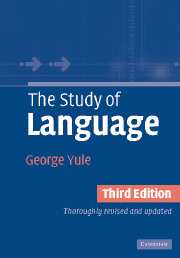Book contents
- Frontmatter
- Contents
- Preface
- The origins of language
- Animals and human language
- The development of writing
- The sounds of language
- The sound patterns of language
- Words and word-formation processes
- Morphology
- Phrases and sentences : grammar
- Syntax
- Semantics
- Pragmatics
- Discourse analysis
- Language and the brain
- First language acquisition
- Second language acquisition/learning
- Gestures and sign languages
- Language history and change
- Language and regional variation
- Language and social variation
- Language and culture
- Appendix: Suggested answers to study questions
- Glossary
- References
- Index
Syntax
- Frontmatter
- Contents
- Preface
- The origins of language
- Animals and human language
- The development of writing
- The sounds of language
- The sound patterns of language
- Words and word-formation processes
- Morphology
- Phrases and sentences : grammar
- Syntax
- Semantics
- Pragmatics
- Discourse analysis
- Language and the brain
- First language acquisition
- Second language acquisition/learning
- Gestures and sign languages
- Language history and change
- Language and regional variation
- Language and social variation
- Language and culture
- Appendix: Suggested answers to study questions
- Glossary
- References
- Index
Summary
After a lecture on cosmology and the structure of the solar system, William James was accosted by a little old lady who told him that his view of the earth rotating round the sun was wrong.
“I've got a better theory,” said the little old lady.
“And what is that, madam?” inquired James politely.
“That we live on a crust of earth which is on the back of a giant turtle.”
“If your theory is correct, madam,” he asked, “what does this turtle stand on?”
“You're a very clever man, Mr. James, and that's a very good question,” replied the little old lady, “but I have an answer to it. And it's this: the first turtle stands on the back of a second, far larger, turtle, who stands directly under him.”
“But what does this second turtle stand on?” persisted James patiently.
To this, the little old lady crowed triumphantly, “It's no use, Mr. James, it's turtles all the way down.”
Adapted from Ross (1967)In the preceding chapter, we moved from the general categories and concepts of traditional grammar to more specific methods of describing the structure of phrases and sentences. When we concentrate on the structure and ordering of components within a sentence, we are studying the syntax of a language. The word ‘syntax’ comes originally from Greek and literally means ‘a putting together’ or ‘arrangement’.
- Type
- Chapter
- Information
- The Study of Language , pp. 86 - 99Publisher: Cambridge University PressPrint publication year: 2005



